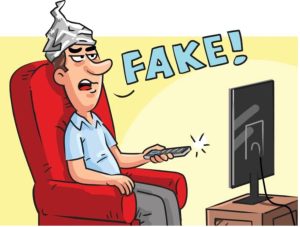Conspiracy theories: The language of extreme belief
18 What to do about conspiracy theories?
Detection
Conspiracy theories, like many forms of information, can be efficiently spread across the internet in an increasingly digital age. Jetten et al. (2022) suggest that conspiracy theories are shaped through economic inequalities which exist with certain demographical groups of people and communities. High levels of economic inequalities are thought to enhance and perpetuate conspiratorial thinking through events which constitute a collective-level crisis. Economic factors can affect the social life of individuals including their cooperation, social cohesion, and more importantly their level of trust. As conspiratorial thinking is often generated through the opposition of elitists, it becomes clear how economic factors can play a major role in its formation. Examining socio-structural contents can be crucial in understanding the formation of conspiracy beliefs because they are believed to be reflected of the times which collectives live in, opposed to the irrational beliefs of individual people (Jetten et al., 2022).

The detection of conspiracy theories is important because of the misleading, outlandish, or harmful implications they may contain, but it is also important to detect which kinds of information may be more susceptible to the creation of conspiracies. Shahsavari et al (2020) analyze conspiracy theories related to the COVID-19 pandemic in 2020 and the detection of content which may be vulnerable to reinterpretation by conspiracy theorists. Through a systematic study they conclude with a list of popular conspiracy theory groupings, explaining how conspiracy theories tend to be groupings of smaller narratives tied together as a single story. Conspiracy theorists typically take a liking to social media and other communicative spaces as opposed to having trust in news media, specifically news media which holds a strong position on a subject. However, unlike typical fact checking, conspiracy theorists do tend to use unbiased media as fuel for their arguments. As with any instance of information detection, it is important to determine the sources which are being used to support a particular set of claims, especially if the sources are unbiased or have little relation to the central argument. Essentially, many conspiracy theorists may use smaller pieces of information to support their central narrative which may only show parts of the truth.
[RL]
References
Jetten, J., Peters, K., & Casara, B. G. (2022). Economic inequality and conspiracy theories. Current Opinion in Psychology, 47, 101358. https://doi.org/10.1016/j.copsyc.2022.101358
Shahsavari, S., Holur, P., Wang, T., Tangherlini, T. R., & Roychowdhury, V. (2020). Conspiracy
in the time of corona: automatic detection of emerging COVID-19 conspiracy theories in
social media and the news. Journal of Computational Social Science, 3(2), 279–
Resistance
more blah

Feedback/Errata